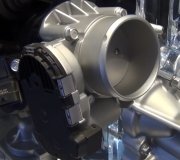I don't know how that valve works on your car but if it has only two wires, it is similar to what Ford uses. If it has four wires it will be similar to a GM or Chrysler system.
With the Ford system, 12 volts is applied to one wire, then the Engine Computer varies the voltage on the other one. The lower it brings that voltage to 0 volts, the harder the spring-loaded solenoid pulls the valve open to allow more air in. If that control wire gets grounded it will make the valve open fully. You'll get the high idle but without the corresponding fuel delivery and power.
As a point of interest, I watched a Chrysler trainer demonstrate how much those valves affect idle speed. He was able to disable six cylinders on a V-8 Jeep engine by unplugging the injectors, and while it obviously ran very poorly, it was able to maintain the desired idle speed on just those two working cylinders. That is a lot of control. On Chrysler engines we can read the "steps" the computer has placed the valve at. There are 256 steps and you'll typically find it at around step 32 for a good-running engine. When you find it at step 0 and the idle speed is too high is when you know the computer has lost control of idle speed but it is trying to lower it as much as possible. That's when you start looking for vacuum leaks. Even with six cylinders disabled it still hadn't reached step 200, so you can imagine how fast the engine would run if that valve was wide open and all eight cylinders were working.
You can't measure any voltages on the Chrysler automatic idle speed motor. The wires are pulsed with varying voltages and polarities to slowly turn the motor which turns the valve on a threaded shaft. You CAN measure the voltage on the Ford unit, and if yours has two wires I would do that too. If you find full battery voltage between the two wires, ... Let me rethink that. You should find 12 volts on one wire, or possibly 5.0 volts. It's the other one you're interested in. If that has 0 volts it has to be because either the circuit in the computer is shorted or that wire is grounded on the engine. By far the most common cause would be the wire got pinched when something was reassembled.
If you do find 0 volts on that control wire, turn the ignition switch off, then measure the resistance of that wire to the engine block. If you find real low resistance, close to 0 ohms, unplug the Engine Computer. If the low resistance is still there, that wire is pinched or rubbed through and touching metal. If the wire reads open circuit, (real high resistance or infinite), that suggests the driver circuit in the computer is shorted.
Monday, June 24th, 2013 AT 10:07 PM



